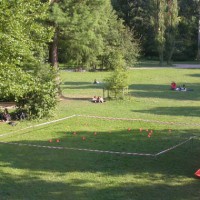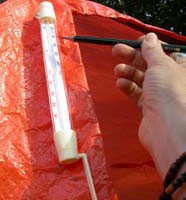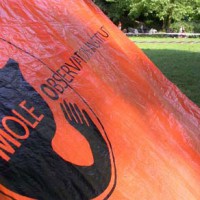Mole Observation Institute
Materials:
Mixed media installation.
Concept:
The ‘Mole Observation Institute’ aims to visualise the continuous underground work of the mole in the historic Ilm Park in Weimar. Those small animals represent an uncontrollable phenomenon, which contrasts the regular and controlled nature of the park. The project consisted of observing and marking the movements of the animals underneath the ground, over the exhibition period, performing the absurd act of analysing an uncontrollable process.
The site, twelve meters square, located next to the historic Sternbrucke (Star Bridge) in front of the city palace, simulates a scientific research station. The artists worked from a temporary structure assembled each morning and removed each evening. They collected and correlated data in a daily routine:
Cycling a three-wheeler bicycle into the park and erecting a fivemeter long tent over the bicycle structure, which then functioned as a worktable and display area; Marking out the observation area with barrier tape; Marking fresh-earth molehills, indicative of overnight activity, with fluorescent beacons; Recording photographic documentation of the research site from a fixed vantage point on the bridge above the field; Removal of the beacons and their replacement with numbered flags; Plotting of the flag positions on to grid paper using an “Alberti’s window” style drawing machine; Measuring the distance between the numbered flag’s and recording the data; Collection of a soil sample for analysis; Temperature, rainfall, and general weather conditions recorded; Dismantling and packing the research station back into the trailer and cycling back to the office.
The mobile unit is a purpose built tricycle and canopy, which acts as a scientific base and provisory display centre to inform the public of results of the research. The noninvasive strategies implemented consisted primarily of observation.
Parodying life as a scientific workstation prompted visitors to engage in real enquiry and discussion to ascertain quite what it was that was happening before them. For this reason in ‘Mole Observation Institute’ the artists avoided promotion of the fact that the action was an art project.
The two artists Flanagan (Australian) and Catanzaro (Italian) had rudimentary skills in German language that added to the curiosity and alien nature of the implantation, they ‘intended their work to resemble, even be mistaken for, life; being in the reality of the world increased the work’s readability as part of the environment rather than artifice.’8
Visitors entered into genuine discussion about the welfare of the moles, but after careful observation of the research station’s data collection techniques, the underlying absurdity of the action became apparent. For example, the use of an Alberti’s Window drawing machine – that is a copy of a device used in the fifteenth century by Western painters in their attempt to define realistic space, by reducing the spatial plain to vertical and horizontal and establishing a vanishing point of perspective. Albrecht Durer describes these machines as a way that artists could “scientifically” depict objects and people by using technology to record an accurate or objective record of their vision.9 Drawings made with such devices were believed to capture reality. The installation operates as a forum for dialogue or social activism as discussions often progress to more philosophical matters. A theme of the project is to mediate on the relationship between humans and nature, in which – in the endeavour to understand and ultimately control the natural world – the dominance of Cartesian thought has led to the belief that this will be achieved by breaking it down into ever-infinite pieces, discarding perception as unreliable and insisting on deduction as the only logical method.
Project Partners:
Beatrice Catanzaro
Exhibition:
Green Space II, Light and Shadow, Weimar Germany, 2003.
Publications:
FLANAGAN, T. & CATANZARO, B. (2004) Mole Observation Institute. IN HOHMANN, K. (Ed.) Public Art and new Artistic Strategies. Weimar, Bauhaus University Weimar, University Publishers. Pp. 60 – 1.
WETZEL, H. (2003) Hitze bremst Maulwürfe im Weimar Ilm Park. Weimarer Allgemeine. 13th Aug. ed. Weimar, Germany. P. 3.
LEONHARDT, U. (2003) Palmenschatten im Gras, Weimar: Das Projekt “Green. Space2” vereint Kunst und Natur. Thüringer Allgemeine. 5th Jul. ed. Weimar, Germany. P. 6.
Multi Media:
http://www.uni-weimar.de/projekte/greenspace/artists.swf. Accessed 16th July 2009.
Thanks:
- Nina Lundström
- Kai Kemann
- Reiner Reisner
- Günter Spitze
Endnotes:
8. JACOB, M. J. (1995) An Unfashionable Audience. IN LACY, S. (Ed.) Mapping the Terrain : New Genre Public Art. Seattle, Wash., Bay Press. P. 52.
9. WOODROW, R. (1997) Analysis of the Visual Image. Newcastle, Australia, University of Newcastle http://www.newcastle.edu.au/department/fad/fi/woodrow/an-words.htm. Accessed 15 October 1997.










